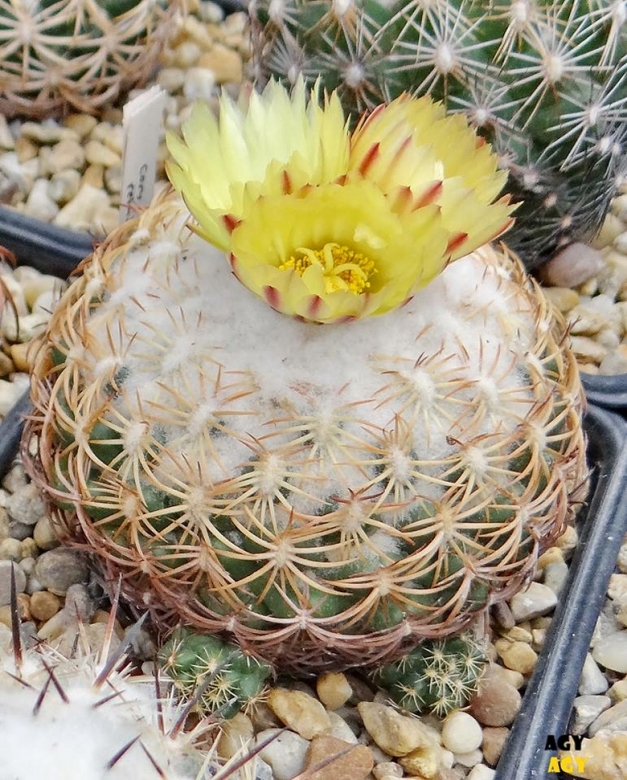Accepted Scientific Name: Coryphantha retusa (Pfeiff.) Britton & Rose
Cactaceae (Britton & Rose) 4: 38. 1923 [24 Dec 1923] nom. cons. prop. Britton & Rose

Coryphantha retusa var. pallidispina Photo by: Agócs György
Origin and Habitat: Mexico.
Synonyms:
See all synonyms of Coryphantha retusa
back
Accepted name in llifle Database:Coryphantha retusa (Pfeiff.) Britton & RoseCactaceae (Britton & Rose) 4: 38. 1923 [24 Dec 1923] nom. cons. prop.Synonymy: 12
back
Description: Coryphantha retusa var. pallidispinaSN|2315]]SN|10405]] is one of the innumerable forms of Coryphantha retusaSN|2315]]SN|2315]] which is one of the most widespread and morphologically variable taxon. Coryphantha retusa var. pallidispinaSN|10405]]SN|10405]] was described by Backeberg (Cactaceae VI: 3874, 1962) as a small greyish-green cactus thickly covered with tawny wool, with 15 yellowish to pale-grey spines, among them 12 more rigid with thickened bases, the other 3 much thinner, close to each other and curved backward. The tubercles more closely set than the type. The flowers are deep yellow and borne from the centre of the plant. It flowers profusely. This pale spined variety is controversial, others forms are similar and plants from other localities look more like it. Field-studies have shown, this is just one form of Coryphantha retusaSN|2315]]SN|2315]].
Remarks: Coryphantha retusaSN|10405]]SN|2315]] is a widespread and variable species that has received an undue number of names. The differences usually concern only the spination, however the colouring, size and density of spines is greatly influenced by the conditions of culture, at lower light levels the spines are less numerous, delicate and white, while with strong solar radiation the spines are stronger with a darker tint. Minor differences can also be found in the colour of flowers sometime with a paler or darker yellow tint, and in the size and shape of tubercles.
Subspecies, varieties, forms and cultivars of plants belonging to the Coryphantha retusa group
 Coryphantha retusa (Pfeiff.) Britton & Rose: has greyish-green stems covered with tawny wool. The yellowish-brown spines are curved backward. Flowers deep yellow borne from the centre. Distribution: Mexico (Oaxaca, Puebla).
Coryphantha retusa (Pfeiff.) Britton & Rose: has greyish-green stems covered with tawny wool. The yellowish-brown spines are curved backward. Flowers deep yellow borne from the centre. Distribution: Mexico (Oaxaca, Puebla). Coryphantha retusa var. pallidispina Backeb.: has 15 yellowish to pale-grey spines, among them 12 more rigid with thickened bases, the other 3 much thinner. The tubercles are more closely set than the type.
Coryphantha retusa var. pallidispina Backeb.: has 15 yellowish to pale-grey spines, among them 12 more rigid with thickened bases, the other 3 much thinner. The tubercles are more closely set than the type.
Bibliography: Major references and further lectures
1) Edward Anderson “The Cactus family” Timber Press, Incorporated, 2001
2) James Cullen, Sabina G. Knees, H. Suzanne Cubey "The European Garden Flora Flowering Plants: A Manual for the Identification of Plants Cultivated in Europe, Both Out-of-Doors and Under Glass" Cambridge University Press, 11/Aug/2011
3) David R Hunt; Nigel P Taylor; Graham Charles; International Cactaceae Systematics Group. "The New Cactus Lexicon" dh books, 2006
4) N. L. Britton, J. N. Rose “The Cactaceae. Descriptions and Illustrations of Plants of the Cactus Family.” Volume 4, The Carnegie Institution of Washington, Washington 1923
5) Curt Backeberg “Die Cactaceae: Handbuch der Kakteenkunde” Gustav Fischer Verlag, Stuttgart New York 1982–1985
6) Reto Dicht, Adrian Lüthy “Coryphantha: Cacti of Mexico and Southern USA” Springer Science & Business Media, 14 March 2006
7) Arias, S. 2013. Coryphantha retusa. The IUCN Red List of Threatened Species. Version 2015.1. <www.iucnredlist.org>. Downloaded on 08 June 2015.
8) Cecile Hulse Matschat “Mexican Plants for American Gardens” Houghton Mifflin, 1935
9) Urs Eggli, Leonard E. Newton “Etymological Dictionary of Succulent Plant Names.” Springer, Berlin/Heidelberg 2010
10) Reto F. Dicht, Adrian D. Lüthy “Nomina Cactacearum Conservanda sive Rejicienda Proposita.” In: Cactaceae Systematics Initiatives. 10: 19–22 2000.
11) Walther Haage "Kakteen von A bis Z", Quelle & Meyer Verlag: Heidelberg, 1986
Cultivation and Propagation: In culture Coryphantha retusa var. pallidispinaSN|10405]]SN|10405]] is without problems, but it grows slowly. It does best in slight shade, but does well in full sun, too. It is sensitive to over-watering (rot prone), and needs a very porous soil with good drainage.
It flowers quite early, but needs about 8-12 years to reach its typical, definite aspect. It tolerates fairly low temperatures as long as it is kept dry (hardy to -5° C or less, for short periods of time).
Propagation: Propagation is by seed.











